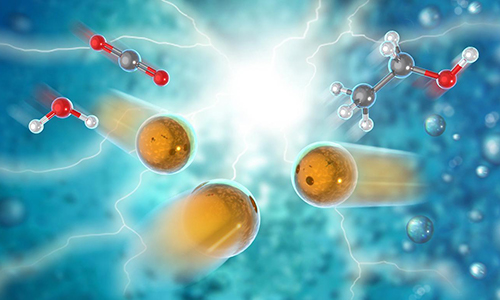|
|
|
|
|
|
|
|
|
|
| |
Everything has a carbon footprint: the amount of carbon dioxide or other greenhouse gas emitted by an activity or the creation and transportation of a product. The way you commute, heat or cool your house, eat, dress, garden—they all influence your footprint. |
|
| |
|
|
|
|
|
|
|
|
|
|
|
| |
| |
|
|
| |
Artist’s rendering of a new process that converts carbon dioxide and water into ethanol. (Image courtesy Argonne National Laboratory) |
|
| |
|
|
|
|
| |
|
|
|
| |
Recycling carbon dioxide emitted from fossil fuel power plants and other industrial processes would reduce the amount of greenhouse gas released into the atmosphere. But carbon dioxide is a stable molecule; transforming it is energy intensive and expensive. A catalyst, which speeds up chemical reactions, could help. |
|
| |
|
|
|
| |
A team led by Argonne and in collaboration with Northern Illinois University and UChicago’s Pritzker School of Molecular Engineering has discovered a new electrocatalyst that converts carbon dioxide and water into ethanol efficiently and economically. |
|
| |
|
|
|
|
|
|
|
| |
|
|
|
| Climate Vault is a new nonprofit that reduces carbon dioxide emissions by purchasing and “vaulting” carbon permits so polluters can’t use them and providing grants for carbon dioxide removal technology. |
|
|
|
| |
|
|
|
|
|
| |
|
|
|
| Lab buildings consume 10 times as much energy as non-lab buildings, with open fume hoods expending a significant amount of power. The Shut the Sash program helped Searle Chemistry Laboratory cut its energy use intensity by 24 percent. |
|
|
|
| |
|
|
|
|
|
| |
|
|
|
| Incorporating granular material into architecture and infrastructure, with no need for binders or glues, could reduce the carbon footprint of the built environment. |
|
|
|
| |
|
|
|
|
|
|
|
|
|
|
|
|
|
| |
The technology relies on immense computing power, consuming vast amounts of energy—almost as much as all data centers in the world combined and with the same footprint as Greater London. As its value grows, so does its environmental impact. |
|
| |
|
|
|
|
|
|
|
|
|
|
|
|
|
| |
| |
Visit the Alumni & Friends website for stories, podcasts, and other features, curated for you on UChicago Review. Create an account for a more personalized experience.
Sign up to receive µChicago monthly. |
|
|
|
| |
|
|
|
|





